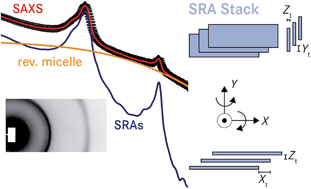Self-assembly of biaxial discorectangular lead carbonate nanosheets into stacked ribbons studied by SAXS and HAADF-STEM tomographic tilt series†
Abstract
The self-assembling behaviour of 2.6 nm thin PbCO3 nanoplatelets with discorectangular shape and uniform width and thickness occurring after their formation in nonionic water-in-oil microemulsions has been investigated using synchrotron small angle X-ray scattering (SAXS) and (scanning) transmission electron microscopy ((S)TEM). The presence of attractive depletion forces originating from the ubiquitous microemulsion droplets triggers a new type of superstructure at low particle concentration. Instead of the universally observed formation of face-to-face assembled lamellar mesostructures, the nanosheets self-organise into extended ribbon structures, whereby each on top lying sheet is displaced by a constant shift in the length and width directions leading to a so far unprecedented staggered zigzag-type stack assembly with restricted height. This type of stacking gives rise to a complex interference pattern in the isotropic small angle scattering of the stacked ribbon assemblies (SRAs) in reverse micellar solution. Different to the, for lamellar-structured nanosheets typical, diffraction peaks at multiples of the wave vector corresponding to one particular repeat distance, the scattering peaks measured in this study are asymmetric, displaying a shoulder on their low wave vector side. The asymmetric shape of the observed face-to-face correlation peaks indicates that the SRAs do not extend in one direction only. Their scattering behaviour is analysed by expanding the Kratky–Porod structure factor for stacking plates into three dimensions. High-angle annular dark-field (HAADF)-STEM tilt series have complementary been acquired to retrieve three-dimensional structural information on the SRAs in the dry state and to confirm the model used for the refinement of the SAXS data.


 Please wait while we load your content...
Please wait while we load your content...